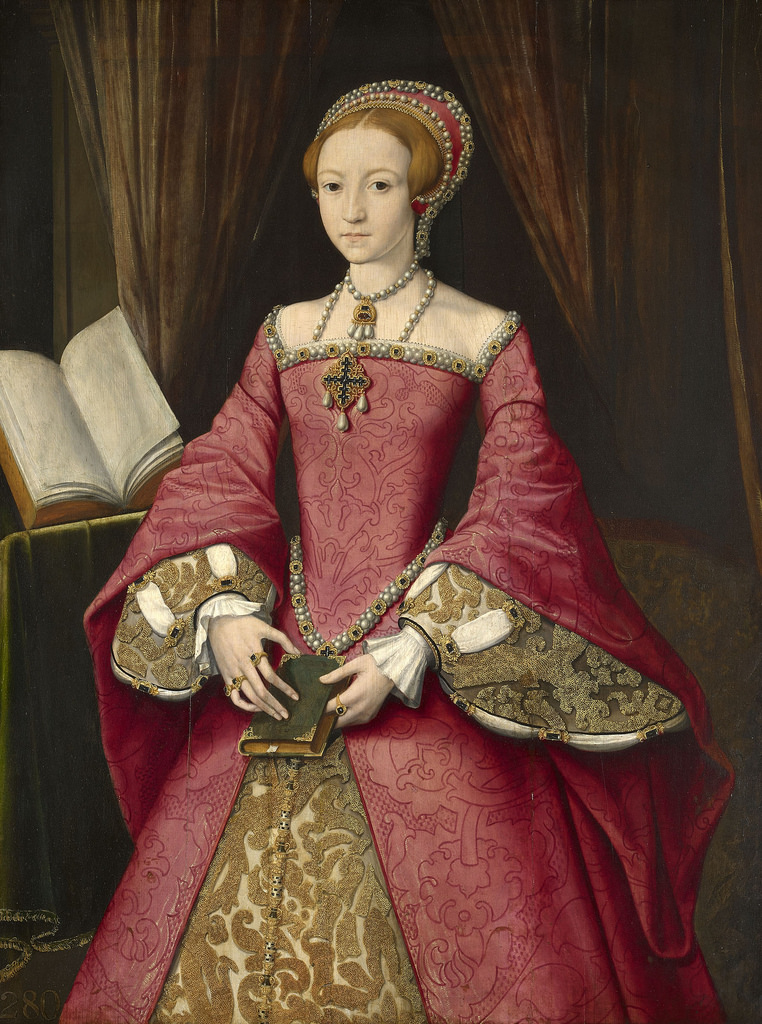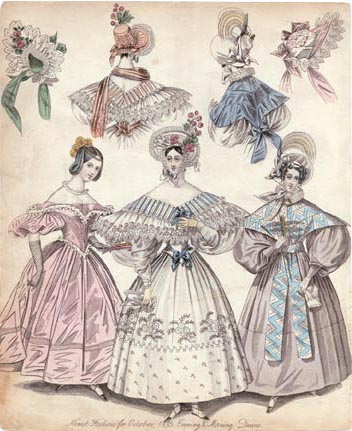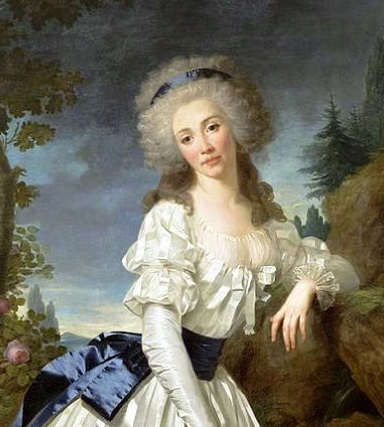Henrican (Tudor) Underthings

by Kimiko Small. Originally published in the January / February 2009 issue of Finery.

When I see people reproduce Henry VIII era (1509-47) ladies costumes, they usually use what they already have for undergarments, which are most often from the later Elizabethan era (1558-1603). While there are similarities, it works best to wear Henrician undergarments under that era’s gowns.
Smock: A basic square-necked smock with regular or full sleeves is the most common, and is worn next to the skin. From the images, a thin band cuff is appropriate to close the sleeves at the wrist. A wide ruffle that drapes over the hand is often seen in paintings. Blackwork embroidery is frequently seen at the ruffle and neckline.
A fuller style has very full sleeves, based on an extant square-necked Italian smock. The upper half of the sleeve at the body is gathered, while the lower part of the sleeve at the body is not gathered, making up for a lack in underarm gusset. It has gores inserted into the center front and back of the smock body to provide fullness. The smock’s lower sleeves should be full if it is intended to pull-out from the bottom of the fore-sleeve of the kirtle, as is seen in Mary Guildford’s portrait (above). Otherwise, the fore-sleeve puff can be faked, which may have been the arrangement for Jane Seymour’s fore-sleeve, and later styles of the 1540s and 1550s.
A high-necked smock appears in a few later images of the time, usually seen under a high necked partlet. This smock also works as a cold weather alternative.
The Petticoat: The petticoat is a skirt that can be worn in the colder months to provide additional warmth, or to provide more flare to the outer skirts. If a farthingale is worn for late Henrician (1545 and later), the petticoat would be worn under the farthingale to cover the legs.
Arnold writes that during the Elizabethan age, “(M)any petticoats were made with ‘a peire of bodies’… These bodies were not stiffened… It seems that a ‘petticoat bodies’ was simply a support to take the weight of the petticoat on the shoulders and avoid too much bulk at the waist. Some petticoats were specified as ‘without bodies’ so presumably they fastened at the waist with ties, or perhaps with the ‘flappes’ and ‘shoulder peces’ which are mentioned in the warrants… It can only be conjecture, but these flaps and shoulder pieces may have been some arrangement like a pair of braces… A woman’s petticoat would have to be held up equally securely to prevent a gap at the waist, as doublets and bodices fitted so tightly.” It is uncertain if such a garment is also worn in a similar manner during Henry’s time, but seems likely. The petticoat is worn directly over the smock. The bodice portion is not padded or stiffened. The skirts can be fully quilted with cotton wadding or flannel if desired for warmth or to give flare and support to the outer skirts, instead of using a farthingale.
Farthingale: The farthingale is the most obvious garment that should be removed from many Henrician recreators wardrobe. While useful, the farthingale was not commonly worn during most of Henry VIII’s long reign, and this will change the look of the Henrician style to the softer style that the English preferred.
Queen Katherine of Aragon brought the farthingale, which was typical of Spanish fashion, to the English court in 1501 when she married Prince Arthur. It was novel enough to have been commented on by the English that they “wore ‘benethe ther wast certain rownde hopys, beryng owte ther gowns from ther bodies after their countray manner.’” But Katherine and her ladies soon abandoned the farthingale for English fashions. Farthingales were described as being used for a court masque in 1519, and are not noted in official court records again until 1545 when one is recorded for Princess Elizabeth. This suggests to me that a farthingale was unusual enough an item to bear specific comment on, and was not worn by the English until 1545, nearly the end of Henry’s reign.
The farthingale pattern would be similar to the later Elizabethan farthingale in the Alcega Tailor’s pattern book (1589). When the farthingale does appear, the outer garments became more exaggerated in size, such as the fore-sleeve with its faked puffs, and the skirts became larger to accommodate the farthingale underneath.
Kirtle Pair of Bodies: There are conflicting reports on how the woman’s torso was supported during this time frame. “Women in portraits and drawings of the 1520s to 1540s wear garments that appear to be sprayed on their bodies,” writes Malcolm-Davies. Trying to determine just how such garments support the body is a similar conundrum. Steele leans toward a tight fitting cloth bodice to provide support, with a “whalebone bodies” coming in sometime during the first half of the century in France. The Cunningtons make no mention of a separate stiffened garment, and calls the kirtle bodice “‘a pair of boddies’ (compare ‘a pair of stays’),” and notes that the bodice was rigid, but not how. Malcolm-Davies suggests a tight fitting kirtle pair of bodies that can be stiffened with interlinings of canvas and buckram, stating, “Buckram is frequently mentioned in association with women’s clothing. It was often stiffened with paste or glue. The ‘paste wyfe’ could also supply wire, which became necessary as the waist changed from a natural line to a point in the 1540s”.
I recommend not using a separate corset or stays. Make the kirtle pair of bodies using firm canvas or similar for interlining. To make the bodies snug to the torso, I take in 2”-3” from my actual measurements. Light boning would be used for those who need some additional support. Mikhaila suggests the following two features to achieve the appropriate look seen in the images of the time: “First, boning must not rise over the bust (as in the extant pairs of bodies) in order to retain the softness which is evident in the portraits. Secondly, the fastening for the stiffened layer must be at the back or sides, and, for the fuller figure, be laced from top to bottom. This draws the bust down and avoids cleavage.”
Using the kirtle bodies is all that is needed to provide the support for the Henrician garments – especially since boned stays do not seem to be known in England prior to the middle of the century, and do not show up in extant wills in England until the last part of the century. A skirt, possibly with a decorative front panel, should be sewn directly to the kirtle pair of bodies.
Keep these undergarments in mind and the proper Henrician look will be easy to achieve, distinguishing this graceful style of fashion from the later Elizabethan styles.
Bibliography
Arnold, Janet. Queen Elizabeth’s Wardrobe Unlock’d, Great Britain, W.S. Maney & Sons Ltd., 1988.
Cunnington , C. Willett & Phillis Cunnington, Handbook of English Costume in the 16th Century, Boston, MA, Plays, Inc., 1970.
Landini, Roberta Orsi and Bruna Niccoli. Moda a Firenze 1540-1580, Lo stile di Eleonora di Toledo e la sua influenza, Edizioni Polistampa Pagliai, 2005.
Malcolm-Davies, Jane and Ninya Mikhaila. The Tudor Tailor – Reconstructing sixteenth-century dress, London, England, B.T. Batsford Ltd, 2006.
Steele, Valerie. The Corset: A Cultural History, New Haven & London, Yale University Press, 2001.
Waugh, Norah. Corsets and Crinolines, New York, NY, Theatre Arts Books, 1954, reprinted 2000.


Leave a comment